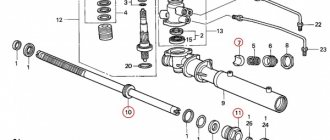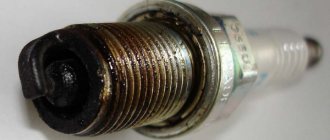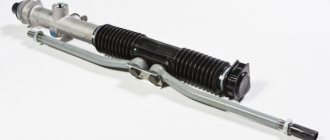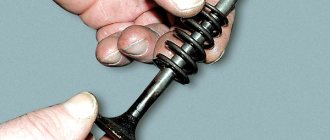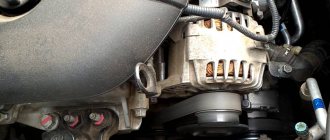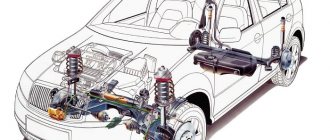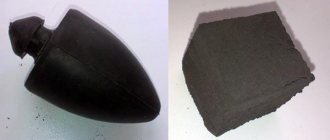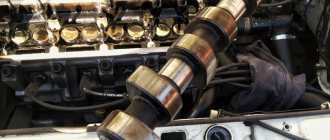Hydraulic compensators are knocking: establishing the reasons
So. Car enthusiasts with extensive experience claim that there will be no knocking on a fully operational car. And if extraneous noise appears, it means something is wrong. Why can these nodes knock?
Among the main reasons are mechanical wear or wear that forms on the surface of the plunger pair. Also, extraneous sounds may occur due to unstable operation of the valve responsible for the oil supply.
The compensators do not knock all at once. Sounds can appear due to wear or failure of even just one part.
“Knocking under the hood” or 5 car noises that should not be ignored
Cyclic “squeal” from somewhere below
A cyclic noise or squealing sound coming from under the wheels often indicates a missing wheel or axle bearing. Typically, the level and type of noise will vary depending on the speed of the vehicle, and at certain speeds the sound may disappear altogether. Such noise cannot be ignored, because if the bearing fails, then there is a risk of the wheel locking, or even worse, the possibility of the wheel coming loose while driving.
Knocking in the engine using the example of the piston 126 engine of the Lada Priora:
Don't confuse wheel bearing noise with scraping or squealing noises that can come from your brakes, especially after rain. Due to bad weather, moisture causes the brake pads to swell slightly. The pads rub slightly, creating annoying squeaks; over time they warm up, the water evaporates and the sound disappears. The sounds of misaligned bearings will not go away until the entire assembly is replaced.
Basics of the design and operation of a hydraulic compensator
The negative side of the design approach is the capriciousness of the system. Very often the hydraulic compensators on the Priora 16 valves knock and the reasons for this phenomenon are unknown to the inexperienced owner. The situation becomes clearer after studying the features of the compensatory mechanism.
Configuration
The idea of automatic regulation of thermal clearances can be implemented in two versions: a conventional hydraulic pusher and a hydraulic support. The latter is used in gas distribution modules with rocker arms. On the Lada Priora in the sixteen-valve version, the intake and exhaust are equipped with individual camshafts. The optimal solution for this arrangement is the use of a hydraulic pusher.
The Priorov hydraulic compensator on the 126 engine consists of the following parts:
- A plunger pair, including a cylindrical cage and a piston with a ball valve.
- The outer housing is a pusher.
- System of grooves and holes for oil supply.
Principle of operation
The oil composition enters the internal cavity of the piston and, overcoming the resistance of the spring, pushes the ball away to fill the closed cylinder. When filling the liner, oil pushes the piston out and the hydraulic tappet rests against the cam. Next, the ball valve is locked and the assembly unit works like a regular pusher on motors with an adjustable valve mechanism.
Various causes and solutions to hydraulic compensator knocking
Next, we will look at the causes of extraneous noise in the hydraulic compensator and how you can eliminate the problem causing it.
- Extraneous sound on startup:
- reason: when the system is idle for a long time, oil leaks from some hydraulic compensators;
- elimination: a short knock of a few seconds is not a sign of a breakdown. Long lasting – has one of the reasons mentioned in the following paragraphs.
- Knocking when cold or hot, but disappears after increasing the speed:
- Reason No. 1: The check valve ball is damaged or worn. Elimination - only complete replacement of the hydraulic compensator;
- Reason No. 2: contamination of the mechanism due to low-quality or dirty oil. Elimination - cleaning the elements from wear products and changing the oil.
- Knocking when hot, but disappears after increasing the speed. There are no problems with a cooled engine:
- reason: oil leaks through the gaps between the plunger and the sleeve, which appeared due to wear. Remedy: replacing the broken hydraulic compensator assembly.
- Knock at high speeds, disappears at low speeds:
- Reason No. 1: foaming of residual oil when there is excess oil in the crankcase due to churning by the crankshaft. The resulting mixture enters the hydraulic compensators. Remedy - restore the oil level to an acceptable amount;
- Reason #2: Low oil level causes the pump to suck in air. Remedy - restore the oil level to an acceptable amount;
- Reason No. 3: The oil sump is deformed due to an impact with the road surface, which damages the oil receiver. Elimination - replacement of defective parts.
- Constant knocking of one or more valves, which does not depend on the intensity of the crankshaft:
- reason: the presence of a gap between the cam and the pusher due to damage or contamination of the mechanism elements. Remedy - check for gaps according to the example described earlier and compare the speed of movement relative to other elements of the hydraulic compensator. Clean parts from dirt and replace damaged parts.
- Knocking when cold:
- reason: rarely happens, but it does happen. This happens to varying degrees of complexity for the same reasons that were described earlier. If the knock is short-lived (a couple of seconds), this does not mean that something is broken. Troubleshooting - Troubleshooting depends on the cause and is fully consistent with the actions for knocking in other situations.
The steering rack is a quiet separate element with sophisticated diagnostics
It often happens that after reassembling the entire chassis, it is time to check the steering rack. By moving the steering wheel left and right, you will hear small knocks if the rack has already begun to wear out. But this does not mean at all that it knocks during operation. It is difficult to give general recommendations here; there are different recommendations for owners of different cars:
- It’s worth visiting specialized forums and reading information about how and when the steering rack fails, how you can check and fix it;
- tightening the steering rack is a solution for a few days; soon it will start knocking again if a problem is identified with this particular element of the car;
- the knock of the rack is often a distinct feedback on the steering wheel, as well as on the body in the area where the control pedals are attached, so diagnosis will not be difficult;
- Sometimes steering tips or rods knock, which is more difficult to check, but you can perform a full diagnosis in a pit without any problems or inaccuracies.
The steering system likes to knock in domestic cars, as well as in cars older than 10 years. Changing the steering rack is very difficult due to the high cost of spare parts and the rather inconvenient location in many cars. Therefore, they prefer to perform this process on a service. Professionals will complete all tasks quite simply and quickly.
Consequences
Incorrect operation of hydraulic pushers can lead to the following problems:
- reduction in compression and engine power;
- deterioration of its launch;
- burnout of valve plates and seats;
- an increase in shock load on vehicle components and parts, which will lead to their rapid failure;
- increase in fuel consumption.
If the knocking of the hydraulic pushers disappears a few seconds after starting the engine, then in this case there is no need to talk about a malfunction of the mechanism.
Hydraulic compensators and “Accent”
The reasons for the knocking are standard here. The owners write that the problem can be solved by changing the oil. More experienced owners believe that if hydraulic compensators knock when cold (Accent is no exception), this is nothing more than a feature of the engines.
But in general, most drivers change oil with a viscosity of up to 5W30, and this allows you to completely get rid of the knocking of these mechanisms in the engine.
Upper rack support
This can also cause knocking in the front suspension over small bumps. On car forums, the topic dedicated to this knock is very popular. The reasons are different for everyone. In attempts to combat this annoying sound, car owners go through the entire suspension, but often the knock remains.
One possible cause is the upper strut support. It consists of a rubber part as a damper and a bearing. If this rubber element has lost its elasticity, then this is the cause of this extraneous knock that all drivers struggle with. In order to find out for sure whether this is so, measure the gap between the limiter and the support. In most cars this is easy to do, but in some models this unit may be closed. If measurements show that the gap is more than 10 mm, then the support must be urgently replaced. However, this gap is not always uniform. When measuring, it is recommended to focus on the average figure. It is worth checking this support carefully: on many cars this sound appears only on one side.
Replacing hydraulic compensators on a Priora (16 valves)
For work, prepare the following tools:
- flat-head, Phillips-head screwdriver;
- socket wrenches;
- You may need a cylinder head gasket; replacing it will allow you to be safe from the fact that the spark plugs may flood the spark plugs with oil;
- sealant;
- magnet - for convenience.
- Stop the car with the handbrake. Lift the hood.
- Loosen the clamp securing the crankcase ventilation hose (main circuit).
- Disconnect the hose from the cylinder head fitting. Cover the fitting with rags to prevent any objects from getting inside.
- Remove the bracket for the wires of the injectors and ignition coils, having first unscrewed the bolts with the “10” head.
- Disconnect the throttle assembly wiring harness from the cylinder head, having first removed the fastenings with the same head.
- Let's move on to the cylinder block cover. All fifteen screws will have to be unscrewed. To do this, use the E-8 head. Please note that it is additionally secured with sealant.
- Therefore, use a plastic screwdriver to carefully pry the cover in places where there are visible gaps, and then lift it. At this point, evaluate the camshaft lobe wear. It should not be covered with chips or other signs of mechanical damage.
- Now you can check the faulty hydraulic compensators. Avoid damaging the valves of the gas distribution mechanism; handle them carefully.
- Remove the faulty hydraulics with a magnet and put new ones in their place, securing them in a level position.
- Along the way, you should inspect all parts, assessing the degree of wear. This will help to find the reasons for the wear of the hydraulics or the consequence - something that has worn out faster due to their improper operation.
- Replace sequentially. Do not forget to coat the cylinder head cover with sealant to ensure maximum adherence to the body.
- Reassemble the components in reverse order, check the operation of the new hydraulic tappets by starting the engine.
Particular attention should be paid to oil seals, as they are most susceptible to wear. The seals of the Russian manufacturer of wear-resistant auto components CS20, which specializes in the production of silicone, polyurethane and rubber spare parts, have proven themselves to be good. Detailed review follow the link.
How hydraulic compensators knock: video
Everything should be nearby, don’t start without preparation
Lada Priora can serve as an example to consider the replacement process. To avoid unpleasant surprises, any work must be planned and everything necessary must be prepared. In our case we will need:
Let's start by disconnecting the battery minus. Then we dismantle the air filter, throttle cables, wires that will interfere with manipulation, injector ignition coils and intake manifold.
Replacing hydraulic compensators on a Priora is complicated by the fact that the manifold mounting bolt is located under the generator.
To get to the hydraulic compensators:
- The generator belt is removed, the generator itself is freed from the mounting bolts and carefully moved to the radiator. Using a wrench with a rotary head, the manifold mounting bolt is unscrewed.
- The ramp with nozzles is dismantled and the air conditioning pipes are disconnected (if equipped).
- The collector is dismantled. First, we lift its left edge and then the entire part, and then we move it to the left.
- The valve cover is removed using a screwdriver inserted into the technological grooves.
- Next, the timing belt is removed, the pulleys, camshaft bed and the shafts themselves are dismantled.
All compensators are open to view, among them it is necessary to identify the faulty ones. This is done by pushing. Defective ones will sag without much effort.
The hydraulic compensators are removed using a magnet. The entire set must be replaced, since they are used in similar conditions and wear should be approximately the same.
The above modifications have engines with a camshaft located on top. But there are also those in which it is located below. In this case, the rocker (rocker arm) acts on the heel of the automobile valve. Replacing hydraulic compensators on a Chevrolet Niva (where the timing belt is designed exactly like this) will be technologically different from what is described, and the “hydraulics” there are of a different type.
Detailed diagnostics of hydraulic compensators on Lada Priora
Sometimes, to determine the causes of knocking hydraulic compensators on a 16-valve Lada Priora engine, the thermal state of the engine alone is not enough. A set of tests makes it possible to more accurately determine the factor that causes extraneous noise.
Diagnosing the condition
One of the common complaints is knocking noise both cold and hot. However, as the speed increases, the symptom disappears. One of the following options is relevant:
- Worn or damaged ball valve. You can't do without replacing the hydraulic compensator.
- Contamination of the internals of the hydraulic fluid with wear products due to the choice of incorrect lubricant or untimely replacement. Washing the internals and changing the oil composition to a standard one eliminates the problem.
If the clatter appears only on a hot power unit and disappears at high speeds, and on a cooled unit no extraneous sounds are observed in any mode, the plunger pair has worn out. The hydraulic compensator must be replaced as an assembly.
The knocking is observed only at high speeds in any thermal state, and at idle there is silence, a problem with the oil level or in the low emulsion suction system. It is not recommended to go beyond the extreme marks on the dipstick; driving with a damaged oil receiver is also not recommended. Restoring the acceptable level resolves the problem.
For your information
- New hydraulic compensators can also tap. This usually happens after capitalization and is observed within a short period of time after the first start-up. It is not a malfunction if it does not recur during subsequent starts.
- If the hydraulic modules knock after changing the oil, the reason is the quality of the lubricant or the filter.
- The knocking of hydraulic pushers during startup should not be considered a malfunction. Over a long period of parking, the oil is drained from the working chambers and at the beginning of work the containers are filled.
Are the consequences dangerous?
What are the consequences of ignoring the fact that the hydraulic compensators on the Lada Priora 16-valve engine are knocking or neglecting to investigate the causes of the noise? At a minimum, acoustic discomfort. At the most, the camshaft cams will wear out and will have to be replaced.
Constant knocking
Diagnostics and repair
Why do hydraulic lifters knock on the Lada Priora and what to do in this case
First of all, it is worth determining which specific hydraulic pusher is not working correctly, and whether they are the cause of the unpleasant sound. This can be done using acoustic diagnostics or by turning off the engine cylinders alternately. For this, it is advisable to contact a car service or do it yourself. However, trying out repair methods yourself can be more expensive than calling an experienced engine specialist.
Then you need to check the oil pressure in the engine system for compliance with the standards. If it is lower than necessary, then the oil pump or filter may need to be replaced.
Often the cause of incorrect operation of the mechanism is engine oil, which was chosen incorrectly or is present in insufficient quantities. It is necessary to change it to another brand, change its viscosity or add special additives to it that eliminate the knocking of hydraulic pushers.
Sometimes you may notice that oil appears in one of the spark plug wells when the engine is running under heavy load. You need to pull it out with a syringe and clean the spark plugs. Then, to create the required pressure in the system, under the cover of the hydraulic compensators and heads, you need to apply sealant, which was “greedy” when assembling the car at the manufacturer.
Hydraulic pushers do not need any adjustment, since they themselves are able to adapt to the operating mode of the mechanisms.
Knock of hydraulic compensators on Lada Priora: diagnostics and troubleshooting
Lada Priora is equipped with a VAZ 21126 engine with an automatic gas distribution mechanism adjustment system. The gap between the camshaft cam and the valve stem is selected by a hydraulic tappet, the successful operation of which is ensured by the engine oil system. The mechanism allows you to avoid making various types of adjustments in the timing belt, reduces fuel consumption and increases the efficiency of the power plant. Fundamentals of the design and operation of a hydraulic compensator
Basics of the design and operation of a hydraulic compensator
Configuration
The idea of automatic regulation of thermal clearances can be implemented in two versions: a conventional hydraulic pusher and a hydraulic support. The latter is used in gas distribution modules with rocker arms. On the Lada Priora in the sixteen-valve version, the intake and exhaust are equipped with individual camshafts. The optimal solution for this arrangement is the use of a hydraulic pusher.
The Priorov hydraulic compensator on the 126 engine consists of the following parts:
- A plunger pair, including a cylindrical cage and a piston with a ball valve.
- The outer housing is a pusher.
- System of grooves and holes for oil supply.
Principle of operation
The oil composition enters the internal cavity of the piston and, overcoming the resistance of the spring, pushes the ball away to fill the closed cylinder. When filling the liner, oil pushes the piston out and the hydraulic tappet rests against the cam. Next, the ball valve is locked and the assembly unit works like a regular pusher on motors with an adjustable valve mechanism.
Why do hydraulic compensators knock on a Lada Priora with 16 valves both hot and cold or causes of noise
Successful operation of the hydraulic compensator (HC) is possible only with a constant supply of oil under pressure. The oil emulsion drainage prevention system allows you to eliminate knocking during startup. It is implemented in the form of a ball valve that closes the oil channel in the cylinder head after stopping the engine.
How the main guns knock
Some owners of Lada Priora have heard about problems with hydraulic pushers, but are not aware of the acoustic nature of the malfunction. It is not difficult to determine whether the modules are rattling: the sound will be similar to the operation of a diesel power plant. Indeed, the clatter can be compared to a running fuel injection pump of a diesel engine or a modern gasoline unit.
Tapping on cold
On the new motor, the hydraulic modules operate silently. This is explained by its ideal condition and confirms the quality choice of lubricant by the manufacturer. Deviations from factory recommendations or mediocre vehicle care require not only decoking of the piston rings in the future, but also a search for the factors that caused the piston ring to knock.
What causes the hydraulic compensators to knock on the Lada Priora 16 valves or the reasons for the knocking when cold can be the following:
- Contaminated or poor-quality oil emulsion.
- Unsuitable oil viscosity. Deviations in viscosity characteristics lead to the inability to push fluid through a small network of channels, which causes oil starvation in hydraulic compensators.
- Clogged oil system holes. A decrease in the flow area leads to a decrease in pressure in the chambers of the hydraulic module.
- Low pressure in the main oil line. Usually the oil pressure light comes on along with this.
- Jamming of the plunger mechanism due to the presence of a large layer of carbon deposits on the surfaces of the assembly unit.
- Wear of plunger pair parts. Defects in the ball valve or on the mating surfaces lead to fluid leaks from the sub-plunger space.
Signs of the need for internal combustion engine repair
The motor wears out constantly as it is used, but up to a certain point it works normally, and nothing indicates the need for repair. Any part has a resource; after it is exhausted, the overall wear will only increase, and the first malfunctions will begin to appear. Signs indicating the need for overhaul of the power unit:
- Oil consumption has increased. It is allowed to reduce the oil level from the maximum to the minimum mark over 1 thousand kilometers. Ideally, consumption should be negligible during the entire time between oil changes.
- Blue smoke comes out of the exhaust pipe.
- There is black carbon on the spark plugs.
- At idle speed the engine is unstable and strong vibrations are felt.
- From the hose for removing gases from the crankcase, a pulsation of exhaust is observed parallel to the increase or decrease in speed. In normal conditions, increasing the speed does not affect the volume of gases in any way.
- Fuel consumption increases. In the combined cycle, gasoline consumption per 100 km can almost double.
- Motor power decreases. If the car accelerates from standstill to 100 km/h with the shift speed increasing from 17 seconds to 25 seconds, and the acceleration does not exceed 130 km/h, it’s time to think about a major engine overhaul.
Acceleration time is measured with one passenger in the cabin, and the maximum speed is “squeezed out” at maximum load.
Considering that our roads leave much to be desired, the engine can be checked without accelerating it to the maximum. To do this, you need to look at what speed the car accelerates to in different gearbox positions. In 1st gear - about 40 km/h, in second - 50-55 km/h, in third - 90-100 km/h. If the acceleration fits within these indicators, the motor is in good condition.
Compression reduction
A drop in compression in the cylinders directly indicates wear. This is typical for VAZ engines. In turbocharged and multi-cylinder engines, air pressure may drop due to, among other things, a violation of the valve timing.
Consequences of reduced compression: the air-fuel mixture does not heat up to the optimal temperature, the combustion process slows down, and the engine is unstable. The greater the wear, the lower the compression meter readings when taking measurements. For the Priora engine, the ideal indicator is 12-13 kgf/cm2, from 10 kgf/cm2 is average, below 9 kgf/cm2 is bad and indicates the need for capital.
The reason for the decrease in compression is the wear of the cylinder walls, piston rings and pistons. For cylinders, it is allowed to increase the size to approximately 0.15 mm, no more. If the performance is high, you will need to replace the block or install pistons with rings of increased diameter. Installing ordinary parts into a cylinder with a lot of wear will give a temporary effect.
You can check the reason why compression has decreased without dismantling the power unit. To do this, the spark plugs are unscrewed, a few millimeters of engine oil are pumped through the well into the cylinders, and the measurement is repeated. An increase in compression indicates wear of the piston rings; if the indicators remain unchanged, the reason is wear or burnout of the valves.
Knocks in the engine
Another clear sign of an imminent overhaul is a knocking sound in the engine. If the crankshaft makes a knock, the sound will be metallic, muffled, and becomes more frequent as the speed increases. The reason is wear of the crankshaft journals and an increase in the axial clearance. The sound is especially noticeable when the speed is gradually increased or decreased.
The connecting rod bearings may knock - the sound appears in neutral gear and intensifies as the speed increases. You can determine the knocking of the connecting rod bearings by unscrewing the spark plugs. Compared to the sound of the main bearings, the knock will be louder. The pistons knock dully. The sound appears when driving under load and increasing speed. Caused by wear of the piston and an increase in the gap between it and the cylinder. The piston pins knock with a metallic sharp sound, which intensifies at idle and appears due to excessive wear of the parts associated with them.
Other signs
You can determine engine wear by some other characteristic signs.
- Reduced oil pressure. The optimal indicator, depending on the viscosity of the lubricant, should be about 1 unit at idle. With an increase in revolutions for every thousand, the oil pressure also increases by 1 unit, that is, 2000 revolutions - 2 units, 3000 - 3.
- Engine malfunctions. An indirect indicator, since increased detonation, early or late ignition can be eliminated by adjustment.
- Popping noises in the exhaust system and “sneezing” of the engine appear when the air-fuel mixture burns when the valves are open.
- Overheating of the power unit, problems with hot starting, engine trouble.
- Worn cylinder head gasket. If the part is “broken,” antifreeze from the jacket will begin to enter the cylinders, and the properties of the oil will be lost. Due to lack of lubrication, friction and temperature increase, and as a result, engine parts begin to deteriorate. When disassembling such an engine, you can notice perfectly clean components - antifreeze washes away traces of soot and oil. Gasket wear can be determined by a decrease in the coolant level, the appearance of an oil film in the expansion tank and white smoke from the exhaust pipe.
Indirectly, the reasons include floating idle speed, but this malfunction is also indicated by a number of other problems. The cause may be worn engine mounts (supports) - vibration appears, the toothed pulley key can be cut off, and the valve timing is disrupted. Excessive fuel consumption begins, the engine runs rough. Replacing engine mounts on a Priora can solve the problem without the need for major repairs.
For the Lada Priora, with proper operation and compliance with the regulations, the norm is about 200 thousand km. Then the parts will wear out naturally, and the power unit will have to be repaired or replaced.
Life hack: hydraulic compensators for a Priora car with 16 valves, device, price
Compensators are needed for automatic valve adjustment; if they were not there, it would be necessary to adjust the valves every 10 thousand, as on 2109. On the Prior, hydraulic compensators knock under different circumstances - and this is not always a malfunction. They have a special knock, so experienced car enthusiasts will recognize it almost immediately.
A knock that comes from the engine of a Priora car is not a very good sign that should alert you. Each car needs to be approached differently. Therefore, when hydraulic compensators on a Priora knock, make proper preparations for repairs - you need to find out what is the reason for what is happening and how you can eliminate it by correcting the situation. In this article, we have collected for you the main signs: why these parts make noise, whether the car is cold or hot.
These parts have 16 valves on the Priora. (if taken as a complete set) they are not so little. The price starts from 4000 rubles and above. Replacing hydraulic compensators is labor-intensive and I don’t recommend getting into the engine yourself without experience. At a service station, such work for a Priora car will cost from 5,000 rubles and more.
The standard “hydriki” for the Priora were inherited from the “ten”. Even the catalog number testifies to this - 21120-1007300-86. A complete set will cost approximately 4,000 rubles. A set from (she collected Priora coupe, Sport and Premier), article number - 1-59718-219, sold in eight pieces, price - about 300 rubles.
Configuration
The idea of automatic regulation of thermal clearances can be implemented in two versions: a conventional hydraulic pusher and a hydraulic support. The latter is used in gas distribution modules with rocker arms. On the Lada Priora in the sixteen-valve version, the intake and exhaust are equipped with individual camshafts. The optimal solution for this arrangement is the use of a hydraulic pusher.
The Priorov hydraulic compensator on the 126 engine consists of the following parts:
- A plunger pair, including a cylindrical cage and a piston with a ball valve.
- The outer housing is a pusher.
- System of grooves and holes for oil supply.
Principle of operation
The oil composition enters the internal cavity of the piston and, overcoming the resistance of the spring, pushes the ball away to fill the closed cylinder. When filling the liner, oil pushes the piston out and the hydraulic tappet rests against the cam. Next, the ball valve is locked and the assembly unit works like a regular pusher on motors with an adjustable valve mechanism.
How to replace hydraulic compensators on Lada Priora?
The transition from adjusting washers, which were used on Soviet “eights” and “nines” to hydraulic compensators (HC), made it possible to abandon manual adjustment of the gaps. However, hydraulic compensators are installed only on 16-valve engines, so owners of 8-valve Prior and Kalin have to adjust the thermal clearances the old fashioned way, with washers. In this article we will talk about how to independently change hydraulic compensators on a 16-valve Lada Priora engine.
Tools and materials
To replace the HA you will need:
- jack;
- safety stand;
- wheel wrench;
- set of open-end wrenches;
- ratchet wrench with a set of sockets and a flexible extension;
- wrench for 10 and 12;
- flat and Phillips screwdrivers;
- clean rag;
- automotive oil-resistant sealant;
- thread locker.
What you need
Before starting work, we recommend that you carefully read the article Why hydraulic lifters knock when hot and cold. If you have hydraulic lifters knocking on a Priora, you will understand what to do. After all, replacing hydraulic compensators is a rather complicated matter, so it is better not to touch the timing belt unless unnecessarily necessary, because incorrect alignment of the crankshaft and camshaft marks can lead to a drop in engine power and damage to the valves. If you decide to change hydraulic compensators, then read about safety precautions for car repair and maintenance in order to responsibly approach wheel removal and work under the car.
Replacing hydraulic compensators
Below are step-by-step instructions that will help you replace hydraulic compensators on a Priora.
- Open the hood, let the engine cool and disconnect the battery.
- Jack up the front right side of the car, install a safety stand, and remove the front right wheel.
- Remove the plastic casing covering the injector, the air filter pipe, and the filter itself.
- Remove the spark plug wires.
- Loosen the two bolts securing the generator and remove the belt from it. If the car has air conditioning, then remove the belt from it too.
- Unscrew all the bolts of the intake manifold (receiver) and remove it. One of the mounting bolts is located under the generator and can be unscrewed using a ratchet and a flexible extension. If you cannot remove the receiver, then follow the next step and then remove the receiver.
- Unscrew and remove the fuel rail and injectors. Plug the nozzle holes with clean cloths.
- Remove all ignition coils.
- Align the crankshaft and both camshafts to the marks.
- Unscrew the tensioner roller bolts and loosen the eccentrics to remove the belt.
- Remove the belt, then unscrew the camshaft gear bolts. Don't lose the shaft keys, they are very small.
- Unscrew the valve cover bolts and remove it.
- Unscrew the bolts of the upper head plate, including the bolts located under the camshaft gears, and remove it.
- Remove the camshafts and replace their seals if necessary.
- Using a magnet, pull out the hydraulic compensators and insert new ones in their place, or replace the faulty one if you know which one it is.
- Clean the valve cover and top head plate of sealant.
- Place the shafts in place and turn so that the cams of the first cylinder are facing up and slightly towards each other.
- Wipe the cylinder head and top plate with a clean rag, then apply new sealant and install the plate onto the head.
- Apply thread locker to the bolts, screw in and tighten with a force of 2 kgf•m (20 N•m).
- Wipe the top surface of the stove and the valve cover with a clean rag, then apply sealant and install the cover in place.
- Apply thread locker to the bolts, screw on the cover and tighten the bolts with a force of 2 kgf•m (20 N•m).
- Install the camshaft gears and tighten their bolts with a force of 7–8 kgf•m (70–80 N•m).
- Align the camshaft and crankshaft gears to the marks and put on the belt.
- Adjust the belt tension using the roller eccentrics and tighten their bolts with a force of 4 kgf•m (40 N•m).
- Check the marks on the camshafts and crankshaft; if everything is fine, turn the engine two revolutions of the crankshaft and check the marks again. If everything is fine, then continue assembling the motor; if not, align the gears to the marks.
- Install the injectors, ramp and receiver, tighten their bolts with a force of 2.5 kgf•m (25 N•m).
- Install the air filter and its pipe.
- Connect all wires and ignition coils.
- Install the decorative plastic cover.
- Put on and tighten the wheel.
- Connect the battery.
- Start the engine. At first, the hydraulic compensators should knock, but after 3-5 minutes the knock should completely disappear. If the sound disappears, you did everything right. If not, then something was wrong.
Assembly nuances
After replacing 16 hydraulic compensators, everything must be restored to its original form. The most important operations in order:
- We clean and degrease the camshafts and seats of the bed and valve cover, both on the parts and on the engine.
- We change the seals, plugs and put both shafts in place. The inlet has a special belt, which is not present on the outlet. This is its distinctive feature.
- Apply Gasket sealant to the mounting location of the camshaft bed and mount it (no gasket required).
- We treat the fit for the valve cover with sealant and mount it (no gasket required).
- We install injectors, condenser tubes, mount the manifold, generator, its belt, pulleys and timing belt.
- We restore the operation of the throttle valve, filter and connect all the wires.
Replacing hydraulic lifters sometimes results in the engine not starting due to lack of compression. As a rule, hydraulic valves are installed oil-filled and it may happen that due to the incompressibility of compensators, some valves will be open. To avoid this, it is necessary to tighten them with a clamp before installation.
How to eliminate the knocking of hydraulic pushers on Lada Priora
Timely and high-quality maintenance of the engine oil system is the key to flawless operation of the hydraulic compensator mechanism. After all, the unit is designed for use throughout the entire resource of the power plant.
Use of recommended lubricant
When the hydraulic pushers just start knocking, the manufacturer recommends changing the lubricant to a proven option. Therefore, when the question arises of what kind of oil to pour in principle, it is worth analyzing reviews to determine the acceptability of a certain model of oil product for hydraulic compensators.
Of course, the best choice for Lada Priora will be the composition recommended by the manufacturer, specified in the instruction manual. However, not all current popular products are included in the list.
An analysis of opinions shows that, indeed, with the universal viscosity of 10W-40 or 5W-40 specified by the factory, not every oil is suitable. For example, Shell Helix Ultra 5W-40 causes knocking already at 15,000 km, while on Liqui Moly Optimal Synth 5W-40 the hydraulics are silent even at 80,000 km.
Reviews show that it is optimal to choose the following lubricants:
- Total Quartz 9000 Energy 5W-40.
- Mobil Ultra 10W-40.
- Wagner Windigo 10W-40.
Flushing
Many owners, in advanced cases, resort to general engine flushing. However, the effectiveness of such an event in the fight against knocking GCs is low. This is explained by poor oil pumpability in the area of the hydraulic pusher chambers.
If changing the lubricant does not help, the best solution is to remove the cylinder head cover and find which hydraulic compensators on the Lada Priora 16-valve engine are knocking and determine the reason for this. Defective parts are identified by diagnosing running resistance with a wooden wedge. A fast movement speed in comparison with other hydraulic supports indicates wear of the hydraulic module, the presence of a constant gap indicates its coking.
Attention! The wooden wedge must be pressed against the non-working surface of the cams.
Effective removal of carbon deposits inside the cylinders is their local washing. Worn assembly modules cannot be repaired.
Additives
Additive compounds help delay identifying the causes and cleaning the timing belt. There are several products available in the market. The most popular products are from Liqui Moly and XADO. The effectiveness of substances depends on the specific case. Fans of motor additives often equate this class of chemistry with a waste of money.
Hydraulic lifters rattled on the Priora, what should I do?
Lada Priora is equipped with a VAZ 21126 engine with an automatic gas distribution mechanism adjustment system. The gap between the camshaft cam and the valve stem is selected by a hydraulic tappet, the successful operation of which is ensured by the engine oil system. The mechanism allows you to avoid making various types of adjustments in the timing belt, reduces fuel consumption and increases the efficiency of the power plant. Fundamentals of the design and operation of a hydraulic compensator
Knocking after replacement
Usually new parts don't knock.
If you still hear sounds, then this is a manufacturing defect or a problem with the valves. In order to perform an accurate diagnosis and make sure that there is nothing wrong with the valves, it is necessary to check their fastenings. There is a possibility that the parts did not shrink as required. We simply tighten them and thereby remove the knock of the hydraulic compensator.
Sources
- https://maslo-5w30.ru/avto/stuchat-gidrokompensatory-priora-16-klapanov-prichiny
- https://medwegonok.ru/dvigatel-lada-priora-16-klapanov-stuchit-gidrokompensator/
- https://avtonomnaya-gazifikaciya.ru/dvigatel/pochemu-stuchat-gidrokompensatory-na-priore.html
- https://zsm-miass.ru/polomki-i-remont/gidriki-na-prioru.html
- https://avtonomnaya-gazifikaciya.ru/dvigatel/kompensatory-priora.html
- https://medwegonok.ru/stuk-gidrokompensatorov-priora-16-klapanov-kak-ustranit/
- https://AvtoSotka.ru/motor/stuk-gidrokompensatorov-na-holodnuyu-priora.html


